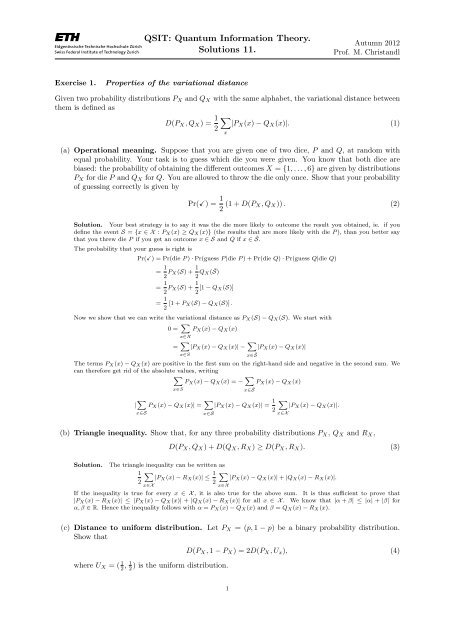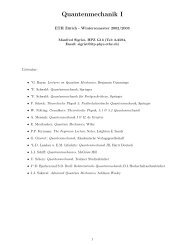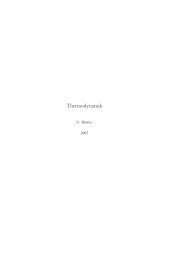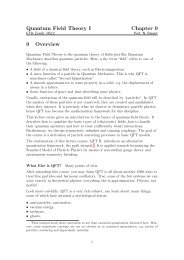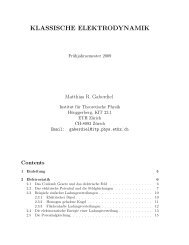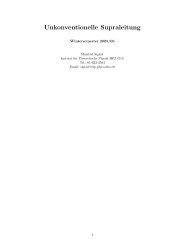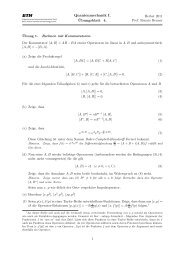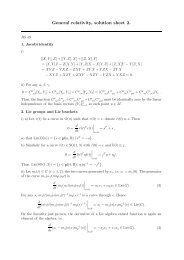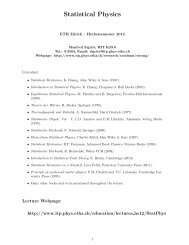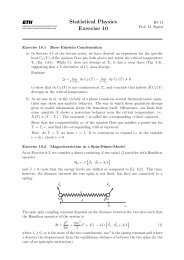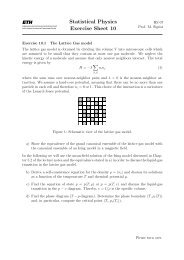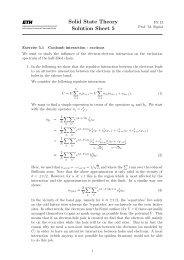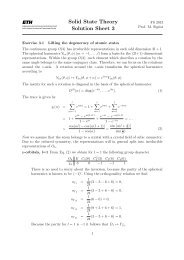QSIT: Quantum Information Theory. Solutions 11.
QSIT: Quantum Information Theory. Solutions 11.
QSIT: Quantum Information Theory. Solutions 11.
Create successful ePaper yourself
Turn your PDF publications into a flip-book with our unique Google optimized e-Paper software.
Solution. We can write<br />
D(P X , 1 − P X ) = 1 ∑<br />
|P X (x) − (1 − P X (x))| = 1 ∑<br />
|2P X (x) − 1| = ∑ 2<br />
2<br />
x<br />
x<br />
x<br />
∣ P X(x) − 1 2 ∣ = 2 D(P X, U X ) .<br />
(d) Joint distributions. Let P XY be a joint probability distribution, with marginals P X and P Y that<br />
have the same alphabet. Show that D(P X , P Y ) ≤ Pr[X ≠ Y ].<br />
Solution.<br />
D(P X , P Y ) = 1 ∑<br />
∣ ∑ P XY (x, y) − ∑ P XY (x ′ , x) ∣<br />
2<br />
x y<br />
x ′<br />
1 ∑<br />
∣ ∑ P XY (x, y) − P XY (x, x) ∣ + 1 ∑<br />
∣ ∑ P XY (x ′ , x) − P XY (x, x) ∣<br />
2<br />
2<br />
x y<br />
x x ′<br />
= 1 ∑ ∑<br />
P XY (x, y) + 1 ∑ ∑<br />
P XY (x, y) = ∑ P XY (x, y) = Pr [X ≠ Y ] .<br />
2<br />
2<br />
x y≠x<br />
y x≠y x≠y<br />
Exercise 2.<br />
Playing Eve<br />
You are Eve, and are trying your best to thwart Alice and Bob’s plans to share a secret key using the<br />
quantum key distribution protocol BB84. You will hack into their insecure quantum channel, capture<br />
the qubit sent by Alice, measure it in some basis, and then send it to Bob. [Note that this is not the<br />
most general attack possible.] You are trying to pick the best possible basis to measure Alice’s qubit.<br />
Remember that you want to minimize the errors that can be detected by Alice and Bob, while trying to<br />
maxime the number of bits you guess correctly. Let’s try a few different bases. For each case, compute<br />
the fraction of bits that you guess correctly, and the error rate induced in Alice and Bob’s key, after<br />
sifting.<br />
(a) In your first attempt, you will measure all of Alice’s qubits in the Z basis.<br />
(b) In your second attempt, you will pick X or Z at random, with equal probability, for each qubit.<br />
(c) More generally, you can measure in an orthonormal basis of the form<br />
{<br />
cos θ 2 |0〉 + sin θ 2<br />
|1〉, cos<br />
θ + π<br />
2<br />
|0〉 + sin θ + π |1〉<br />
2<br />
For instance, picking θ = 0 gives you the Z basis, while θ = π 2<br />
results in the X basis. What happens<br />
for θ = π 4 ?<br />
}<br />
.<br />
Solution. The solution to this exercise is attached on page 4.<br />
Exercise 3.<br />
Chained Bell inequalities<br />
Consider the following setting. Alice and Bob own one black box each. Alice’s box takes an input a from<br />
a set A = {0, 2, . . . , 2N − 2} and outputs a bit x ∈ {0, 1}. Similarly, Bob’s box takes an input b from a<br />
set B = {1, 3, . . . , 2N − 1} and outputs y ∈ {0, 1}.<br />
We define the following measure of correlations,<br />
I N = Pr(X = Y |A = 0, B = 2N − 1) +<br />
∑<br />
|a−b|=1<br />
Pr(X ≠ Y |A = a, B = b) (5)<br />
We want I N to be small, because then it is possible to show that the outcomes of adjacent inputs a and<br />
b = a ± 1 are the same, and unknown to an adversary, with high probability. [This is a generalization of<br />
the theorem from the lecture, with I 2 ↦→ I N .]<br />
2
(a) We will see a physical example of a family of “black boxes” that achieves I N → 0. Each box<br />
corresponds to a quantum measurement device that acts on a single qubit. The qubits to be<br />
measured, one in Alice’s box and one in Bob’s, are maximally entantled.<br />
Let {|↑〉, |↓〉} be an orthonormal basis for a qubit (for instance the Z basis). Suppose that Alice’s<br />
choices of input a correspond to a POVM {E0 a , E1 a }, on a single qubit, with E0<br />
a is the projector<br />
onto state | a<br />
2N π〉, and Ea 1 is the projector onto state | ( a<br />
2N + 1) π〉, with |θ〉 = cos θ 2 |↑〉 + sin θ 2 |↓〉.<br />
The same holds for Bob’s measurements b. Furthermore, suppose that the POVMs on Alice’s and<br />
Bob’s sides act each on a qubit of the Bell state √ 1 2<br />
(|00〉 + |11〉) .<br />
Show that, in these conditions,<br />
I N = 2N sin 2<br />
π<br />
4N ≤ π2<br />
8N . (6)<br />
Solution. The solution to this exercise is attached on page 7.<br />
(b) How would you adapt the protocol from the lecture to take advantge of this Bell inequality?<br />
Solution. By measuring in such a basis, Alice and Bob can achieve a lower “secrecy” value I N → 0 (for large N)<br />
instead of I 2 , and the two key bits will differ with lower probability.<br />
3
Solution to Exercise 2.<br />
4
Solution to Exercise 2.<br />
5
Solution to Exercise 2.<br />
6
Solution to Exercise 3 (a).<br />
7


